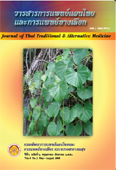Chemical Quality of Gynostemma pentaphyllum (Thunb.) Makino Thai and Chinese Cultivars Cultivated in Thailand
Main Article Content
Abstract
Panchakhan or Gynostemma pentaphyllum (Thunb.) Makino (Cucurbitaceae) is of interest as a potential crude drug. It possesses various activities, such as anti-tumor, anti-lipemic, anti-inflammatory and inhibiting nitric oxide synthesis; G. pentaphyllum is cultivated for commercial purposes in Thailand from native or Thai and Chinese cultivars. Since both cultivars contain similar active constituents, dammarane-type saponins, called gypenosides to distinguish one from the other, the chemical aspects of G. pentaphyllum between Thai and Chinese cultivars purchased from northern and northeastern regions of Thailand were examined. It was found that they had similar color reaction and froth test, but the TLC fingerprints were different. In addition, the other characteristic properties of both cultivars were also similar.
Article Details
References
2. Backer CA. Bakhuizen van den Brink RC. Flora of Java 1963;1:305-6.
3. Craib WG. Florae Siamensis Enumeratio. 1931;1:766.
4. สถาบันวิจัยสมุนไพร กรมวิทยาศาสตร์การแพทย์ กระทรวงสาธารณสุข. สมุนไพรน่ารู้ (๒) ปัญจขันธ์ gynostemma pentaphyllum (Thunb.) Makino. กรุงเทพฯ : โรงพิมพ์การศาสนา; 2548, หน้า 1-11, 45-82.
5. Takemoto T, Arihara S, Nakajima T, Okuhira M. Study on the constituents of Gynostemma pentaphyflum Makino. I. structures of gypenosides I-XIV. Yakugaku Zasshi 1983;103:173-85 (in Japanese).
6. Li L, Jiao LP. Lau BHS. Protective effect of gypenosides against oxidative stress in phagocytes, vascular endothelial cells and liver microsomes. Cancer Biother 1993;3:263-72.
7. Kuwahara M, Kawanishi F, Komiya, T, Oshio H. Dammarane saponins of Gynostemma pentaphyllum Makino and isolation of malonylginsenosides-Rb 1 -Rd and malonylgypenoside V. Chern Pharm Bull 1989;37:135-9.
8.Cui J-F, Eneroth P, Bruhn JG. Gynostemma pentaphyllum: identification of major sapogen ins and differentiation from Panax species. Eur J Pharm Sci 1999;8:187-91.
9. Zhou HP. The saponin constituents and pharmacology of Gynostemma pentaphyllum Mak. Yao Xue Tongbao 1988;23:720-4 (in Chinese).
10. Piacente S, Pizza C. New dammarane-type glycosides from Gvnostemma pentaphyllum. J Nat Prod 1995;58:512-9.
11. Hu L, Chen Z, Xie Y. New triterpenoid saponins from Gynostemma pentaphyllum. J Nat Prod 1996;59:1143-5.
12. Hu L Chen Z. Xie Y. Dammarane-type glycosides from Gynostemma pentaphy/Jum. Phytochemistry 1997;44:667-70.
13. Yin F, Hu L, Lou F, Pan R. Dammarane-type glycosides from Gynostemma pentaphyllum. J Nat Prod 2004;67:942-52.
14. Takemoto T, Odashima T. Antitumor saponins from Gynostemma pentaphyllum. Rohto Co., Ltd. assignee. Jpn Kokai Tokkyo Koho JP 58 59,921 183 59,9211 ICI A61 K311575), 09 Apr 1983, Appl 81/157,925 02 Oct 1981 [in Japanese).
15. Takemoto T. Gynosaponins extraction from Gynostemma pentaphyflum . Nippon Shoji Co, Ltd assignee. Jpn Kokai Tokkyo Koho JP 59 80,696 184 80,6961 (CI C07J17/00), 10 May 19B4, Appl 83/170,422 14 Sap 1983 (in Japanese).
16. Takemoto T. Gynosaponins extraction from Gynostemma pentaphyflum .Nippon Shoji Co, Ltd assignee. Jpn Kokai Tokkyo Koho JP 59 80.700 184 80,7001 (CI C07J17/00), 10 May 19B4, Appl 83/170,426 14 Sep 1983 (in Japanese).
17. Megalli S, Aldan F. Davies NM. Roufogalis BD. Phytopreventativeanti-hyperlipidemic effects of Gynostemma pentaphyflum in rats. J Pharm Pharmaceut Sci 2005;8:507-15.
18. Lin JM, Lin CC, Chiu HF, Yang JJ, Lee SG. Evaluation of the anti inflammatory and liver-protective effects of Anoectochi/us formaosanus, Ganoderma /ucidum, Gynostemma pentaphyllum. Am J Chin Med 1993;21:59-69.
19. ไชยยง รุจจนวเวท, ดวงตา กาญจนโพธิ์, ดวงตา อมรเลิศพิศาล. The anti-gastric ulcer effect of Gynostemma pentaphyllum Makimo. Phytomedicine 2004;14:431-5.
20. Circasta C. Pasquale RD. Occhiuto F. Cardiovascular effects of the aqueous extract of Gynostemma pentaphyllum Makino. Phytomed 2005;12:638-43.
21 . Aldan F, Henness S, Roufogalis BD, Ammit AJ. Gypenosides derived from Gynostemma pentaphyflum suppress NO synthesis in murine macrophages by iNOS enzymatic activity and attenuating NF-KB mediated iNOS protein expression. Nitric Oxide 2003;8:235-42.
22. Huang TH-W, Tran VH, Roufogalis BD, Li Y. Gypenoside XLIX, a naturally occurring gynosaponin, PPAR-alpha dependently inhibits LPs induced tissue factor expression and activity in human THP-1 monocytic cells. Toxicol Appl Pharmacal 2007;218:30-6.
23. Huang TH-W, Tran VH, Roufogalis BD, Li Y. Gypenoside XLIX, a naturally occurring gynosaponin, PPAR-<1 activator, inhibits cytokine induced vascular cell adhesion molecule-1 expression and activity in human endothelial cells. Eur J Pharmacal 2007;565:158-65.
24. Huang TH-W, Razmovski-Naumovski V, Salam NK, Duke RK, Tran VH, Duke CC, et a/. A novel LXR-<1 activator identified from the natural product Gynostemma pentaphyllum. Biochem Pharmacal 2005;70:1298-308.
25. เอมมนัส อัตตวิชญ์, ทรงพล ชีวะพัฒน์, ทรงพล ผดุงพัฒน์,จารีย์ บันสิทธิ์, เย็นจิตร เตชะดำรงสิน, และคณะ. Chronic toxicity of Gynostemma pentaphyllum. Fitoterapia 2004;75:539-51.
26. วิชัย โชควิวัฒน, ชวลิต สันติกิจรุ่งเรือง, เย็นจิตร เตชะดำรงสิน, นัยนา วัฒนาเมธี, นิตยาพร ตันมณี, ปราณี ชวลิตธำรง และคณะ. การศึกษาเปรียบเทียบคุณภาพของปัญจขันธุ์พื้นเมืองและพันธุ์จีน. วารสารการแพทย์แผนไทยและการแพทย์ทางเลือก 2548;3:52-69.
27. Thai Herbal Pharmacopoeia Valli. Department of Medical Sciences,Ministry of Public Health. Bangkok : Prachachon Co., Ltd.; 2000. p. B9, 13H!, 141-2.
28. World Health Organization. Quality Control Methods for Medicinal Plant Materials. Geneva, Switzerland. 1998.
29. Parle YH, Hong YH, Park, WK. A study on the mineral contents of Dolwoe tea (Gynostemma pentaphyflum Makino). Han'guk Yongyang Siklyong Hakhoechi 1987;16:105-9.


